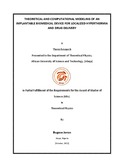| dc.contributor.author | Bugase, Jonas | |
| dc.date.accessioned | 2017-01-09T15:37:41Z | |
| dc.date.available | 2017-01-09T15:37:41Z | |
| dc.date.issued | 2011-10-24 | |
| dc.identifier.uri | http://repository.aust.edu.ng:8080/xmlui/handle/123456789/535 | |
| dc.description.abstract | The advent of nanotechnology together with Biomedical Microelectro-Mechanical Systems (BioMEMS) for improved efficacy in treatment of cancer has resulted in the development of an implantable biomedical device for localized hyperthermia and drug delivery. This thesis work develops a mathematical framework based on relaxation losses of heating mechanism of magnetite magnetic nanoparticles synthesized with the Polydimethylsiloxane (PDMS) gel encasement. Numerical solution of the mathematical model developed showed explicit dependence of the temperature rise of the device on frequency and amplitude of the external applied field, relaxation time and volume fraction of the nanoparticles and implicitly on the viscosity of the PDMS gel and radius of the nanoparticles. A linear dependence of the temperature rise on the amplitude and frequency of the field was observed for usable range of values of the Radio Frequency field. Similarly for the viscosity of the gel and volume fraction the nanoparticles, it is approximately linear but saturates at a maximum value and then declines.
This result was found to be in conformity with other predicted theoretical and experimental findings. This research shows that hyperthermia therapeutic temperature of 41 – 46 o C can achieved with frequency and amplitude ranges of 2.16 – 2.19 kHz and 9.77 – 9.89 kA/m respectively. Also, that for the range of the viscosity and volume fraction of the nanoparticles are 1.1 – 1.2 mPa.s and 0.12 – 0.14 respectively. Simulation of the heat diffusion profile of the implant and its surrounding tumor in 2D and 3D using a finite element simulation package Abaqus/CAE 6.9 showed that for maximum generated heat of 52 o C and 55 o C maintained the temperature of the tumor within the therapeutic range for more than thirty minutes. However, for a temperature 45 o C, the temperature falls a little below the therapeutic range but will be very useful in treatment for longer time periods. The generated heat in these cases is also seen to be enough to serve as the transition temperature for the thermosensitive drug loaded hydrogel embed in the device with micro channels for release since the drug release kinematic of the gel occurs between 37 o C and 45 o C. | en_US |
| dc.description.sponsorship | AUST | en_US |
| dc.language.iso | en | en_US |
| dc.subject | Bugase Jonas | en_US |
| dc.subject | Prof Wole Soboyejo | en_US |
| dc.subject | Biomedical Device | en_US |
| dc.subject | Localized Hyperthermia and Drug Delivery | en_US |
| dc.subject | Modeling | en_US |
| dc.subject | 2011 Theoretical Physics Theses | en_US |
| dc.title | Theoretical and Computational Modeling of an Implantable Biomedical Device for Localized Hyperthermia and Drug Delivery | en_US |
| dc.type | Thesis | en_US |

